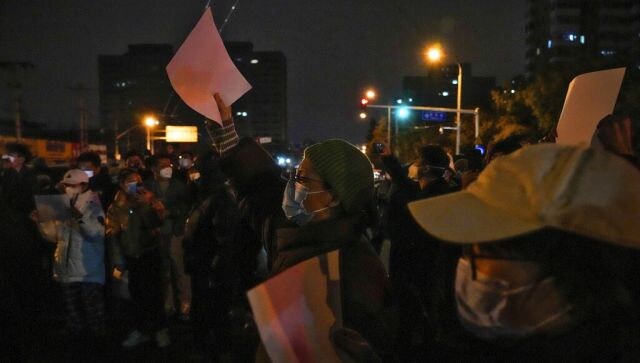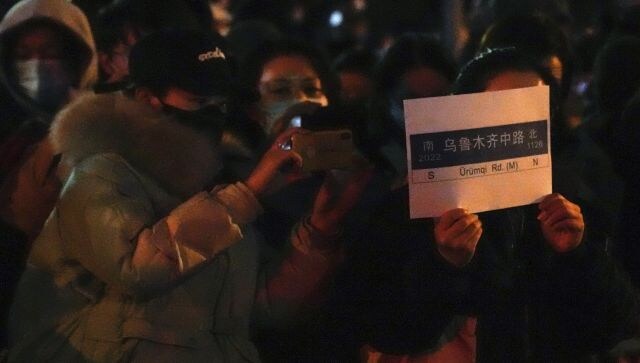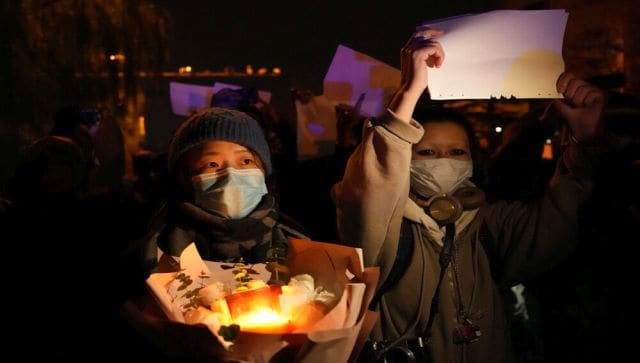Explained: What China’s growing COVID protests mean for Xi Jinping
[ad_1]
It’s unusual to protest in China. It’s even more unprecedented for these protests to spread.
The demonstrations against the country’s oppressive zero-COVID policy erupted over the weekend and have flared up. Protesters are demanding freedom and democracy. The anger is palpable in Beijing, Shanghai and other major cities. Universities in Nanjing, Chengdu, Wuhan, where the novel coronavirus was first detected, are among other places where people are seen raising their voices against the excesses of the Communist Party regime.
Protests in China are not rare. What *is* rare, are multiple protests over the same issue, at the same time, across the country. The protest below, apparently in central Beijing’s liangmaqiao, is astounding #China #protests pic.twitter.com/UHJCqqF1YG
— Tom Mackenzie (@TomMackenzieTV) November 27, 2022
Why did the protests erupt?
A deadly fire, which claimed 10 lives and left nine injured last Thursday, in Urumqi, the capital of the far-western region of Xinjiang triggered the protest. Locals allege that the lockdown hampered the rescue operations. However, authorities have denied the claim.
There are videos of the screams of the families burning in that building in Urumqi. This is the spark that lit the fuse of the protests across China
“Open the doors! Open the doors! Save us!”
Even children were killed pic.twitter.com/cTSt6F5yXc
— Jack Posobiec ?? (@JackPosobiec) November 28, 2022
Videos, which are going viral on social media, despite China’s censorship, show residents marching toward a government building chanting, “Lift lockdowns!” The next morning authorities in Urumqi promised to lift the lockdown in stages but did not address the protests or clarify the timeline for easing restrictions.
This failed to quell the rage in a city, which has already been under lockdown for more than 100 days.

A blank white sheet of paper has emerged as a protest symbol in China. AP
How did the protests spread?
Soon, the anger spread beyond Urumqi and Xinjiang. Large protests took place in Beijing and Shanghai, two of the biggest cities in the country.
In Shanghai, a candlelight vigil was held to mourn the victims of the fire on Wulumuqi Middle Road, named after Urumqi, the city in Xinjiang. Protesters were heard chanting, “Need human rights, need freedom” as many held up blank sheets of paper, symbolising strict censorship in China.
By Sunday, more cities joined the stir – Beijing, Chengdu, Guangzhou and Wuhan. Campuses also saw students pouring into the streets. Prestigious institutions of Peking University and Tsinghua University in Beijing, and the Communication University of China, Nanjing saw demonstrations, according to CNN.
On Monday, police detained protesters from the Wulumuqi Middle Road, which has emerged as the main protest site in Shanghai.
The demonstrations found some support in Hong Kong, where two small events were held. Two mainland Chinese students held flowers and gave out leaflets at the University of Hong Kong (HKU), asking others to express condolences to the victims of the Urumqi fire, reports BBC. Another group of students lit candles at the Hong Kong University of Science and Technology (HKUST).

Zero-Covid restrictions in China have led to a widespread backlash, posing a huge challenge to the Communist Party regime. AP
What are the protesters demanding?
The stir started against China’s zero-COVID policy but now protesters are demanding more freedom; some even democracy.
White sheets of paper have emerged as a protest tool – a stand against China’s strict censorship. “There was definitely nothing on the paper, but we know what’s on there,” a woman who participated in a protest in Shanghai told the BBC.
Rarer than the protest was the anger against Chinese president Xi Jinping. Demonstrators in some cities were publicly calling for the leader to step down; others demanded that the Communist Party should go.
In Shanghai, they sang The Internationale, a socialist anthem, used during pro-democracy protests in Tiananmen Square in Beijing in 1989, according to a report by CNN. In the southwestern metropolis of Chengdu, large crowds chanted, “Opposition to dictatorship!” They went on to shout, “We don’t want lifelong rulers. We don’t want emperors!” This was a reference to Xi who started his third term in office last month, defying norms, CNN reports.

Chinese police officers block off access to a site where protesters had gathered in Shanghai on Sunday. Protests against China’s strict “zero-COVID” policies resurfaced in Shanghai and Beijing on Sunday afternoon, continuing a round of demonstrations that have spread across the country since a deadly apartment fire in the northwestern city of Urumqi led to questions over such rigid anti-virus measures. AP
What does this mean for Xi Jinping?
Dissent is almost unheard of in China, where criticising the Communist Party or the leader could earn protesters time in prison. Now, the growing protests come as a big challenge to Xi and the political party whose biggest priority is to remain in power.
Xi did not expect that the anger against the draconian zero-COVID policy would snowball into unprecedented demonstrations, calling for his ouster. It does not help that despite the restrictions, the nation has failed to curb a spike in cases. On Monday, China recorded 40,052 new Covid cases, a fifth straight daily record, up from 39,506 a day earlier, according to a BBC report.
Three years after the outbreak, China is struggling to reopen. It did not focus on building ICU units or ramping up vaccinations. The country poured all its resources into lockdowns, mass testing, and building quarantine centres. And now all of it seems in vain; it’s a big failure for Xi, who has endorsed the zero-COVID policy.
The strategy had takers at the start of the pandemic as the COVID-19 death toll in China remained lower than in other nations. “It has become unsustainable, though; more infectious strains of the disease have raised the economic cost and practical challenges of eradicating outbreaks, just as the population wearies of the policy,” says a report in Bloomberg.
As protests continued, authorities eased anti-virus rules in the country in scattered areas but stood by its zero-COVID stance. The government did not comment on the protests or criticism of Xi.
“The longer the unrest goes on, the more it spreads, and — above all — the more overtly it targets the party and Xi, the greater the chance of a severe crackdown that would deal a blow to an already-weakened economy and further damage investor confidence,” the Bloomberg report says.
The first impact of the protests was seen on Monday, as Chinese stock markets and the yuan tumbled. The situation has caused an upset in financial markets in the Asia-Pacific region, with concerns rising about the impact on growth in the world’s second-largest economy.
The Communist Party regime gives a lot of importance to stability. It has continued to wrest control by ensuring that people might not have freedom but they have financial security and social order But now the delicate balance is under significant strain, a report in Sky News points out.
The protests have made headlines across the world but the Chinese state media reported on the severity of the outbreak. The ruling party newspaper People’s Daily called for its anti-virus strategy to be carried out effectively, indicating Xi’s government has no plans to change course. “Facts have fully proved that each version of the prevention and control plan has withstood the test of practice,” a People’s Daily commentator wrote.
Another opinion piece published by the news agency Xinhua said, “Practices have proven that our Covid measures can stand the test of history, they are scientific and effective… Perseverance prevails.”
However, China’s rising COVID numbers and the anger on the streets tell a different story.
With inputs from agencies
Read all the Latest News, Trending News, Cricket News, Bollywood News,
India News and Entertainment News here. Follow us on Facebook, Twitter and Instagram.
[ad_2]
Source link


Comments are closed.